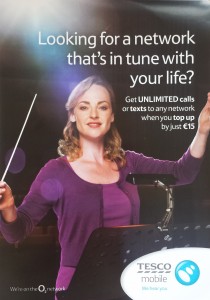When we think of mobile operators in Ireland, we tend to think of the big four: Vodafone, Three, Meteor and (for the moment) O2. We often forget Ireland’s Mobile Virtual Network Operators (MVNOs). In fact there are plenty of virtual network operators in Ireland.
What is a Mobile Virtual Network Operator?
Well, the answer’s in the name. These are companies that offer a mobile phone service to customers, but do not own their own network infrastructure – rather, they strike deals to use one of the traditional mobile operators’ networks. Sometimes the network owners do deals with MVNOs that go after niches that the big operators are not interested in, and sometimes the regulators force the traditional operators to do deals with MVNOs. MVNOs typically have lower setup costs but lower margins, and they tend to targer specific smaller markets.
You will have heard of most of Ireland’s MVNOs
- Launched in 2010, Postfone is, as the name implies, owned by An Post. Its key strength
 is An Post’s chain of retail outlets. It focuses on customers with relatively simple mobile needs looking for low-cost mobile service from a trusted brand. It uses Vodafone’s mobile network.
is An Post’s chain of retail outlets. It focuses on customers with relatively simple mobile needs looking for low-cost mobile service from a trusted brand. It uses Vodafone’s mobile network. - 48 Months (launched in 2012) looks like an MVNO but it’s not one. It is a brand owned by Telefónica O2. It is aimed at 18 to 22 year olds (yes, I know, that’s 5 years, i.e. 60 months, not 48…) and at those older or younger who wish they were that age. 48 months don’t offer phones at all, just free SIMs and very simple all-you-can-eat pricing. Go conquer…

- Lycamobile, launched in Ireland in 2012, is the Irish branch of the multinational MVNO aimed squarely at the international calls market. Lycamobile operates in 17 countries through various brands. In Ireland, Lyca uses the O2 network. If you are looking for low cost calls abroad, check out Lyca.
- Tesco mobile is another on the O2 network. Tesco aim at the value segment and the loyal customers of their supermarkets. Tesco’s phones are also popular with transatlantic tourists for their Irish holidays.
- Is eMobile an MVNO? No, it’s Eircom’s brand focussed on postpaid mobile consumers. It uses (of course) Meteor’s network. Postpaid MVNOs are relatively rare.
For a full list of licenced mobile operators in Ireland including MVNOs, check out Comreg’s page here.
The MVNOs’ impact on the Irish mobile market is growing, but still pretty limited: Measuring market share by number of subscriptions (not revenue) and excluding the data-only SIMs, we see that two of the MVNOs have significant market share. Tesco have 4.5%, Lycamobile have 2.1% and the others between them have 0.3%. Put another way, of about 4.75M voice SIMs in Ireland, about 320,000 of them are on MVNOs. (48 Months and eMobile subscriber numbers are reported within O2’s and Eircom’s market shares respectively.)
MVNOs past and rumoured…
In October 2010, two brave lads launched JUST Mobile, an innovative MVNO not linked to a retailer, a consumer brand or a telco. It used the Vodafone network. JUST Mobile ran into distribution challenges and suffered from the lack of a known brand, and closed about a year later.
The telecoms industry is abuzz with rumours that UPC will soon launch an MVNO on Three’s network. This would turn UPC into a powerful quad-play operator.
The future for Ireland’s Mobile Virtual Network Operators?
Some larger countries have a large number of MVNOs – Germany has many MVNOs including Aldi Talk and niche operators such as Ay Yildiz, a Turkcell-owned MVNO aimed at Turkish people in Germany. Ireland is too small to support such niche operators, but as the trend towards convergence of telecoms and TV services accelerates, it looks more and more likely that in future, Ireland will have a small number (probably three) of triple / quad-play telecoms & TV providers and a few niche players (in the mobile space, that will be the MVNOs) serving those that don’t want a converged offering from a big brand.


Pingback: The end of the telco as we know it? | The Irish Telecoms BlogThe Irish Telecoms Blog
Pingback: Delicate tradeoffs ahead for Carphone Warehouse | The Irish Telecoms BlogThe Irish Telecoms Blog